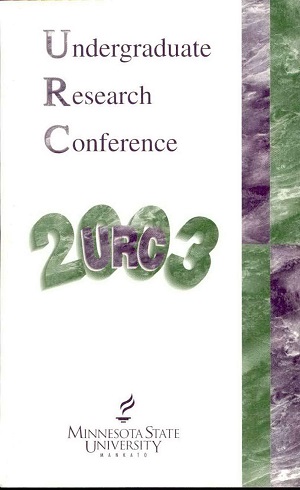Prairie Potholes: How Isolated Wetlands are Affected by Human Decisions
Location
CSU
Student's Major
Biological Sciences
Student's College
Science, Engineering and Technology
Mentor's Name
Bertha Proctor
Mentor's Department
Biological Sciences
Mentor's College
Science, Engineering and Technology
Description
The Supreme Court, in June of 2001, allowed for the use of an isolated wetland, which was formed from an abandoned sand and gravel pit, to be used for a landfill by SWANCC. This was an overturning of a previous decision of a lower court for the lawsuit SWANCC vs. Army Corps of Engineers (ACE) because ACE would not give a permit to allow the landfill. The wetlands were considered protected, under the definition of wetland at the time; areas that are inundated or saturated by surface or ground water at a frequency and duration sufficient to support, and that under normal circumstances do support, a prevalence of vegetation typically adapted for life in saturated soil conditions. The fact that it was breeding grounds for heron protected it under the Migratory Bird Rule. Because of this decision for the landfill to proceed, many isolated wetlands are not covered under the Clean Water Act, Section 404. Prairie potholes are a type of isolated wetland that account for less than ten percent of the total number of wetlands. The loss of these may have far reaching impacts. To possibly show these impacts, I am studying a watershed of the Minnesota River. Using GIS, I will show how wetland losses, especially prairie potholes, can affect ecological, economical, and environmental health in that area.
Prairie Potholes: How Isolated Wetlands are Affected by Human Decisions
CSU
The Supreme Court, in June of 2001, allowed for the use of an isolated wetland, which was formed from an abandoned sand and gravel pit, to be used for a landfill by SWANCC. This was an overturning of a previous decision of a lower court for the lawsuit SWANCC vs. Army Corps of Engineers (ACE) because ACE would not give a permit to allow the landfill. The wetlands were considered protected, under the definition of wetland at the time; areas that are inundated or saturated by surface or ground water at a frequency and duration sufficient to support, and that under normal circumstances do support, a prevalence of vegetation typically adapted for life in saturated soil conditions. The fact that it was breeding grounds for heron protected it under the Migratory Bird Rule. Because of this decision for the landfill to proceed, many isolated wetlands are not covered under the Clean Water Act, Section 404. Prairie potholes are a type of isolated wetland that account for less than ten percent of the total number of wetlands. The loss of these may have far reaching impacts. To possibly show these impacts, I am studying a watershed of the Minnesota River. Using GIS, I will show how wetland losses, especially prairie potholes, can affect ecological, economical, and environmental health in that area.



